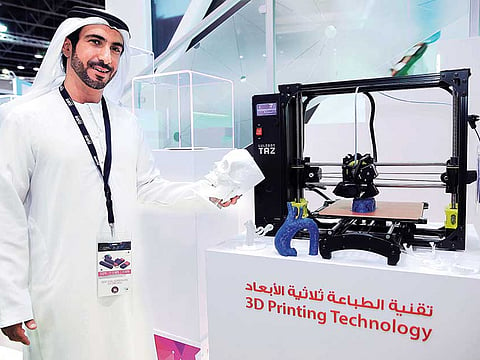Dubai doctors make global impact with 3D printing strides
Removal of complex kidney tumour using new technology tops series of breakthroughs

Dubai: In less than two years of embracing 3D printing, Dubai doctors have made a global impact by using the first-ever 3D printing model as a tool to remove a highly complex renal tumour, a top official of the Dubai Health Authority (DHA) has said.
Force to reckon with
Speaking to XPRESS, Dr Mohammad Al Redha, director of the Department of Organisational Transformation at DHA, said the case handled by Dubai Hospital’s Dr Yaser Saeedi, consultant urologist, and Dr Kais Kotiesh, urology specialist, was published in the prestigious Journal of 3D Printing in Medicine in its August 11, 2017 edition, making Dubai a force to reckon with in the rapidly developing field of 3D printing.
Pathbreaking. This 3D printed model helped Dr Yaser Saeedi of Dubai Hospital to operate on a 43-year-old woman smoker and remove a complex malignant mass from her right kidney while saving the organ
Dr Redha said the pathbreaking 3D printed model of the kidney was used to operate on a 43-year-old woman smoker whose right kidney had a highly complex malignant mass that was accidentally discovered during an assessment for symptoms of colic.
3D Printing is here to stay. Seveteen companies are active in this space in Dubai. We are looking for more partners to print medical devices and intra-operative tools.”
Dr Saeedi said, “The model proved vital in pre-surgical planning, patient education and was of great intraoperative value as we could localise and remove the tumour, making an otherwise high-risk procedure uneventful and smooth.”
Guidance tool
The doctor said although the patient was booked for partial, or possibly radical, nephrectomy or removal of the kidney, the organ could be saved as the 3D model served as an effective guidance tool to localise the tumour.
He said, 3D printing is here to stay. From a septal heart defect and a brain aneurysm to prosthetic legs, dental moulds and crowns, 3DP has been for a variety of applications so far. He said Dubai is one of the world’s biggest labs and testing grounds, so going forward, DHA would like to explore 3DP for medical devices, medications, even working organs (bioprinting).
Dr Redha said, “Seventeen companies are currently active in Dubai in the 3DP space, of which three are advisers. DHA is looking for partners to print medical devices like hearing aids and also intra-operative tools like pins and plates.”
DHA’s 3D Printing milestones
Septal heart defect: One of the first instances where DHA explored the 3D printing route with Medativ entailed a septal heart defect, which is a birth defect in which there is a hole in the wall (septum) that divides the upper chambers of the heart.
A 3D printed prosthetic leg
Concept prosthetic leg: In May 2017, Dubai scored a first when it gave a British expat amputee the region’s first-ever fully 3D-printed prosthetic leg, paving the way for prosthetics to be produced at half the cost of conventional methods in a span of two weeks instead of three months. Earlier, it had created a prototype for a 70 kilogram patient to understand how the 3D technology works. The model was displayed at Arab Health 2017.
Dental moulds and crowns: DHA handled 4,607 3DP cases in 2017 with 3D printed crowns and moulds being produced with great precision and in record time - a 3D impression of the mouth obtained with a 3D scanning wand is sent to a 3D printer which can make up to 18 moulds in six hours. There are 22 doctors and 10 technicians who are specialised in this domain.
Brain aneurysm: Dubai doctors saved the life of a 60-year-old Omani woman who suffered from a cerebral aneurysm with the help of a custom 3D-printed model of the patient’s brain dilated arteries to help plan the complex surgery.
Acccording to Dr Abdullah Qasim, consultant and head of neurosurgery at Rashid Hospital, who handled the case, the surgery would have taken longer and the risk would have been higher without the 3DP model because it would have meant conducting the surgery with limited understanding of the abnormality.
Kidney tumour: DHA has so far successfully removed renal tunours in two patients, both of which were complex and high risk cases.
Sign up for the Daily Briefing
Get the latest news and updates straight to your inbox


